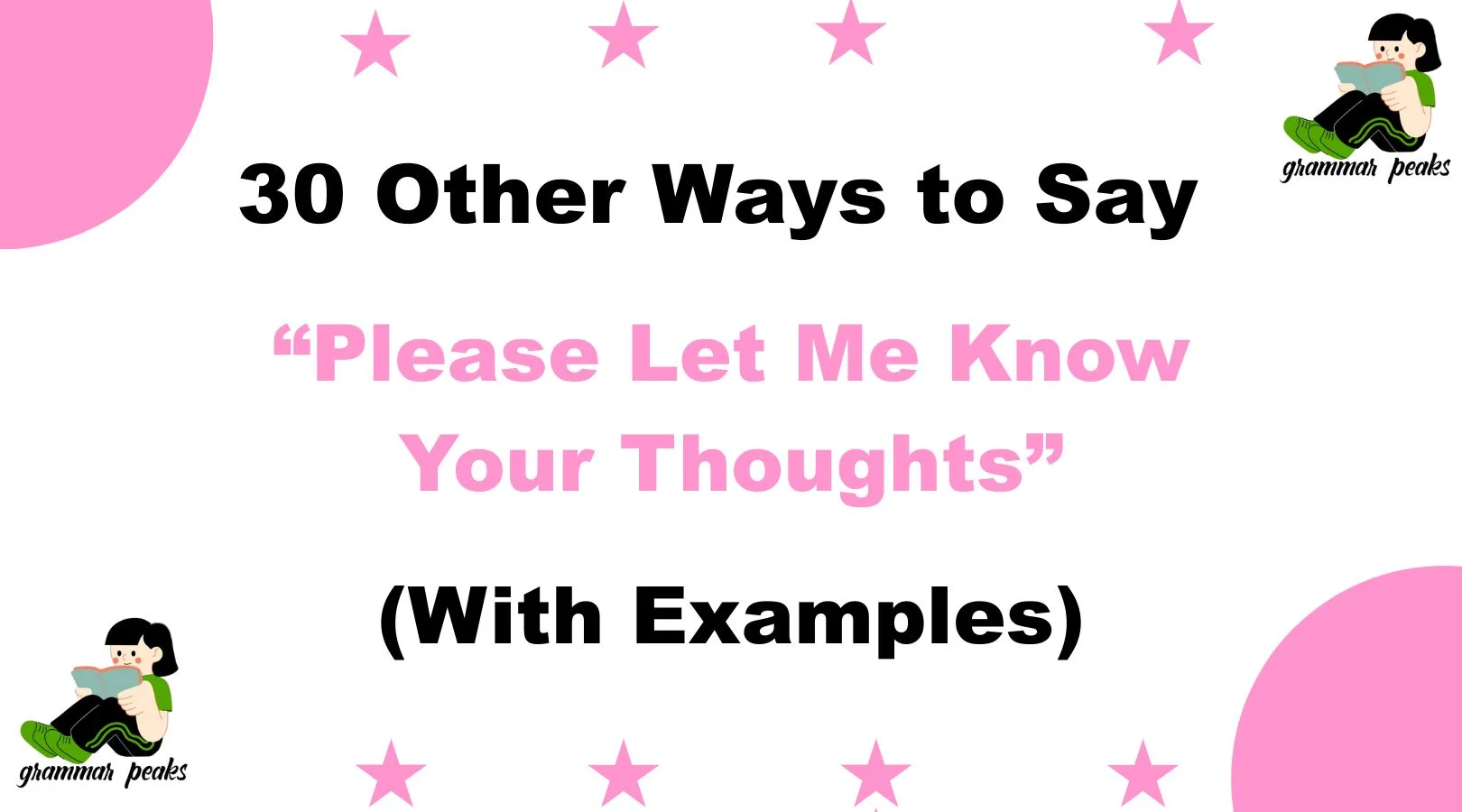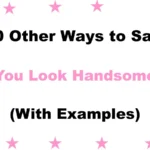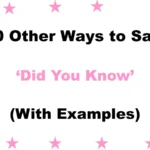Finding the right words to ask for someone’s opinion is more than just a formality—it’s a way to show genuine care and respect. Saying “please let me know your thoughts” is common, but sometimes it can feel a bit routine or impersonal. When we express ourselves with more warmth and creativity, our messages become more inviting and meaningful.
Whether you’re writing an email, text, or message, having a variety of ways to request feedback can help you connect more deeply and encourage honest communication. In this article, you’ll discover 30 thoughtful alternatives to say “please let me know your thoughts”, along with clear explanations, examples, and advice on when to use each one.
What Does “Please Let Me Know Your Thoughts” Mean?
The phrase “Please let me know your thoughts” is a polite and respectful way to ask someone for their opinion, feedback, or reaction to something you’ve shared. Whether it’s a message, idea, plan, or document, this expression shows that you value the other person’s perspective and are genuinely open to hearing what they think
When to Use “Please Let Me Know Your Thoughts”
Use this phrase when you want to:
- Encourage open and honest feedback.
- Show respect for someone’s opinion.
- Maintain a polite and professional tone.
- Request input without pressure.
It’s ideal when you want to keep communication friendly yet formal enough for business or professional contexts.
Is It Professional/Polite to Say “Please Let Me Know Your Thoughts”?
Yes, it is both professional and polite. It communicates respect and openness without being too demanding. However, depending on your audience or context, you might want to choose an alternative that sounds more casual, enthusiastic, or specific to keep the conversation lively.
Pros and Cons of Using “Please Let Me Know Your Thoughts”
Pros:
- Clear and direct.
- Polite and respectful.
- Universally understood.
Cons:
- Can sound repetitive or generic.
- Might lack warmth or personality.
- Sometimes too formal for casual conversations.
Synonyms for “Please Let Me Know Your Thoughts”
- I’d love to hear what you think.
- What are your thoughts on this?
- Please share your feedback with me.
- I welcome your opinion.
- Could you let me know how you feel about this?
- I’m eager to get your input.
- Let me know what you make of it.
- Your thoughts would be greatly appreciated.
- I look forward to hearing your views.
- Please tell me what you think.
- How do you feel about this?
- I value your perspective.
- Could you provide your insight?
- I’m interested in your take on this.
- Would love to get your feedback.
- Let me know your perspective.
- Please give me your honest opinion.
- What’s your reaction?
- Share your thoughts when you can.
- I appreciate your input on this.
- What do you make of this?
- Please let me have your feedback.
- Can you tell me your thoughts?
- I’d appreciate hearing your view.
- Your feedback means a lot to me.
- How does this sit with you?
- Would love to hear your ideas.
- I’d be grateful for your thoughts.
- Let me know what you think when you get a chance.
- Feel free to share your opinion.
1. I’d Love to Hear What You Think
Definition: A warm, inviting way to ask for someone’s opinion.
Detailed Explanation: This phrase expresses eagerness and genuine interest in the other person’s viewpoint.
Scenario Example: I’ve shared the draft with you. I’d love to hear what you think.
Best Use: Friendly emails, informal conversations, or when encouraging open dialogue.
Worst Use: Highly formal or legal communication where precise language is required.
Tone: Warm, inviting, conversational.
2. What Are Your Thoughts on This?
Definition: A straightforward and polite question inviting feedback.
Detailed Explanation: It directly asks for an opinion but remains neutral and professional.
Scenario Example: We’re considering changing the schedule. What are your thoughts on this?
Best Use: Business meetings, email requests, team collaborations.
Worst Use: Emotional or highly sensitive situations that require more empathy.
Tone: Neutral, professional.
3. Please Share Your Feedback With Me
Definition: A polite request for comments or critique.
Detailed Explanation: Focuses on constructive responses and invites detailed input.
Scenario Example: Here’s the project plan. Please share your feedback with me.
Best Use: Workplace communications, performance reviews.
Worst Use: Casual conversations or when seeking personal opinions.
Tone: Formal, respectful.
4. I Welcome Your Opinion
Definition: An open and respectful invitation to express views.
Detailed Explanation: Signals humility and appreciation for the other person’s insight.
Scenario Example: Before we finalize the proposal, I welcome your opinion.
Best Use: Professional settings where collaboration matters.
Worst Use: Situations requiring quick, simple responses.
Tone: Respectful, open.
5. Could You Let Me Know How You Feel About This?
Definition: A gentle request asking for emotional or personal reactions.
Detailed Explanation: Encourages sharing of feelings, not just facts.
Scenario Example: I’m planning a new approach. Could you let me know how you feel about this?
Best Use: Personal or team discussions involving change or sensitive topics.
Worst Use: Strictly analytical or data-driven conversations.
Tone: Empathetic, caring.
6. I’m Eager to Get Your Input
Definition: An enthusiastic and polite way to request someone’s thoughts or feedback.
Detailed Explanation: This phrase conveys a sense of anticipation and genuine interest in what the other person has to say.
Scenario Example: Before we finalize the design, I’m eager to get your input.
Best Use: Team projects, collaborative tasks, creative reviews.
Worst Use: Highly formal legal or executive communications.
Tone: Energetic, respectful, collaborative.
7. Let Me Know What You Make of It
Definition: A casual and friendly phrase asking for someone’s interpretation or opinion.
Detailed Explanation: This expression adds a relaxed tone and invites a natural conversation about the content or idea.
Scenario Example: Here’s the outline I’ve come up with—let me know what you make of it.
Best Use: Creative settings, informal discussions, feedback on drafts.
Worst Use: Serious or sensitive matters that require formal tone.
Tone: Casual, inviting, conversational.
8. Your Thoughts Would Be Greatly Appreciated
Definition: A humble and sincere request for someone’s opinion or advice.
Detailed Explanation: Shows gratitude in advance and signals respect for the person’s perspective.
Scenario Example: I’m considering a career move—your thoughts would be greatly appreciated.
Best Use: Seeking advice, mentoring, leadership feedback.
Worst Use: In high-pressure or rushed environments where time is short.
Tone: Appreciative, warm, thoughtful.
9. I Look Forward to Hearing Your Views
Definition: A respectful way to say you’re expecting someone’s input.
Detailed Explanation: Suggests that their opinion matters and that you’re genuinely waiting for it.
Scenario Example: I’ve included all the details in the document—I look forward to hearing your views.
Best Use: Professional communications, planning meetings, group decisions.
Worst Use: Very casual conversations with friends or close peers.
Tone: Polite, professional, anticipatory.
10. Please Tell Me What You Think
Definition: A simple and direct way to ask for feedback or a response.
Detailed Explanation: It’s polite without being overly formal, and keeps the tone clear and open.
Scenario Example: Here’s the first draft—please tell me what you think.
Best Use: Everyday communication, friendly check-ins.
Worst Use: High-stakes or formal proposals where tone needs to be more polished.
Tone: Direct, neutral, approachable.
11. How Do You Feel About This?
Definition: A gentle invitation to share personal or emotional feedback.
Detailed Explanation: Goes beyond analysis by encouraging the person to reflect on their emotional reaction.
Scenario Example: We’re thinking of changing the team structure. How do you feel about this?
Best Use: Sensitive conversations, team changes, conflict resolution.
Worst Use: Technical or analytical reviews.
Tone: Empathetic, soft, sincere.
12. I Value Your Perspective
Definition: An affirmation that the person’s opinion is respected and appreciated.
Detailed Explanation: This phrase not only invites feedback but also compliments the person for their insight.
Scenario Example: I’ve shared the plan with you because I value your perspective.
Best Use: Professional peer review, coaching, collaboration.
Worst Use: Situations requiring neutrality or limited input.
Tone: Respectful, appreciative, collaborative.
13. Could You Provide Your Insight?
Definition: A formal and respectful way to ask for thoughtful feedback.
Detailed Explanation: Focuses on the person’s experience, judgment, or expertise.
Scenario Example: I’d love your thoughts on this strategy—could you provide your insight?
Best Use: Business settings, academic discussions, expert analysis.
Worst Use: Casual conversation or quick team check-ins.
Tone: Professional, intellectual, respectful.
14. I’m Interested in Your Take on This
Definition: A conversational phrase that invites someone’s point of view.
Detailed Explanation: This expression feels natural and encourages sharing unique or personal insights.
Scenario Example: We’re exploring some new options—I’m interested in your take on this.
Best Use: Team discussions, idea brainstorming, creative review.
Worst Use: Formal emails or executive summaries.
Tone: Casual, curious, engaging.
15. Would Love to Get Your Feedback
Definition: An informal yet appreciative way to ask for comments.
Detailed Explanation: It combines enthusiasm with respect, suitable for friendly or creative settings.
Scenario Example: Just finished this presentation—would love to get your feedback.
Best Use: Design critiques, performance evaluations, informal conversations.
Worst Use: Formal requests or authoritative communication.
Tone: Friendly, enthusiastic, respectful.
16. Let Me Know Your Perspective
Definition: Invites someone to share their unique view or stance.
Detailed Explanation: Encourages a personalized response and shows that multiple viewpoints are welcome.
Scenario Example: This issue seems layered—let me know your perspective.
Best Use: Strategic planning, group discussions, multi-voice collaborations.
Worst Use: Simple decision-making or one-way communication.
Tone: Inclusive, thoughtful, open.
17. Please Give Me Your Honest Opinion
Definition: A sincere request for unfiltered feedback.
Detailed Explanation: Shows you trust the person and want truth over politeness.
Scenario Example: I want to improve—please give me your honest opinion.
Best Use: Mentorship, performance feedback, growth conversations.
Worst Use: Fragile topics where honesty could hurt unnecessarily.
Tone: Trusting, direct, vulnerable.
18. What’s Your Reaction?
Definition: A short, clear way to ask for someone’s initial response.
Detailed Explanation: Invites a real-time or emotional response more than a formal review.
Scenario Example: I just shared the proposal—what’s your reaction?
Best Use: Spontaneous check-ins, first impressions.
Worst Use: Formal reviews or in-depth feedback settings.
Tone: Candid, spontaneous, casual.
19. Share Your Thoughts When You Can
Definition: A polite and non-urgent request for feedback.
Detailed Explanation: Respects the other person’s time while still inviting input.
Scenario Example: Here’s the link to the draft—share your thoughts when you can.
Best Use: Remote teams, asynchronous work, polite follow-ups.
Worst Use: Time-sensitive projects.
Tone: Courteous, laid-back, considerate.
20. I Appreciate Your Input on This
Definition: Acknowledges and values someone’s contribution before they give it.
Detailed Explanation: Sets a respectful tone and encourages them to share freely.
Scenario Example: Before we go live, I appreciate your input on this.
Best Use: Collaborative projects, peer editing, group discussions.
Worst Use: Cold or formal communication needing strict objectivity.
Tone: Grateful, affirming, positive.
21. What Do You Make of This?
Definition: A casual yet thoughtful way to ask someone for their interpretation or opinion.
Detailed Explanation: This phrase implies that you value the other person’s ability to think critically and creatively.
Scenario Example: I’ve been thinking about this concept—what do you make of this?
Best Use: Creative discussions, brainstorming, peer conversations.
Worst Use: Formal business communication or academic essays.
Tone: Curious, relaxed, engaging.
22. Please Let Me Have Your Feedback
Definition: A polite and professional way to invite critique or suggestions.
Detailed Explanation: This version adds formality and shows genuine willingness to receive input.
Scenario Example: Attached is the project outline—please let me have your feedback.
Best Use: Workplace reports, evaluations, project planning.
Worst Use: Friendly chats or text messages.
Tone: Polite, formal, respectful.
23. Can You Tell Me Your Thoughts?
Definition: A gentle and straightforward question inviting someone to share their opinion.
Detailed Explanation: This form is less formal than the original phrase but still courteous and clear.
Scenario Example: I’m not sure if this is the right approach—can you tell me your thoughts?
Best Use: Mentoring conversations, team planning.
Worst Use: Highly formal settings or executive communication.
Tone: Soft, approachable, sincere.
24. I’d Appreciate Hearing Your View
Definition: A humble and appreciative request for someone’s personal or professional opinion.
Detailed Explanation: This phrase conveys both respect and gratitude for their time and perspective.
Scenario Example: We’re at a crossroads with this decision—I’d appreciate hearing your view.
Best Use: Collaborative decisions, input from colleagues or peers.
Worst Use: Light or informal communication.
Tone: Gracious, thoughtful, slightly formal.
25. Your Feedback Means a Lot to Me
Definition: An emotionally expressive way of asking for input.
Detailed Explanation: This phrase shows that you don’t just want feedback—you deeply value it.
Scenario Example: You’ve helped me grow a lot—your feedback means a lot to me.
Best Use: Mentoring, personal development, close colleagues.
Worst Use: Corporate memos or neutral performance reviews.
Tone: Emotional, sincere, appreciative.
26. How Does This Sit With You?
Definition: A casual and intuitive way of checking how someone feels about something.
Detailed Explanation: This phrase focuses on comfort, alignment, and emotional response.
Scenario Example: We’re thinking of moving the deadline—how does this sit with you?
Best Use: One-on-one conversations, sensitive topics, team dynamics.
Worst Use: Formal writing or unfamiliar audiences.
Tone: Informal, empathetic, relational.
27. Would Love to Hear Your Ideas
Definition: An enthusiastic and friendly way to ask for creative or fresh input.
Detailed Explanation: This phrase encourages open brainstorming and innovation.
Scenario Example: We’re still refining the pitch—would love to hear your ideas.
Best Use: Team projects, ideation sessions, creative collaborations.
Worst Use: Technical reviews or closed-loop decision making.
Tone: Friendly, optimistic, energizing.
28. I’d Be Grateful for Your Thoughts
Definition: A warm and respectful phrase that expresses appreciation in advance.
Detailed Explanation: It shows humility and recognizes the effort it takes to give feedback.
Scenario Example: Here’s the revised layout—I’d be grateful for your thoughts.
Best Use: Cross-team feedback, respectful collaborations, academic circles.
Worst Use: Informal chats or rushed meetings.
Tone: Grateful, respectful, formal.
29. Let Me Know What You Think When You Get a Chance
Definition: A patient and polite way to ask for input without pressure.
Detailed Explanation: This version acknowledges that the person may be busy, keeping the tone light.
Scenario Example: Send over the branding mockup—let me know what you think when you get a chance.
Best Use: Emails, DMs, remote work follow-ups.
Worst Use: Urgent matters requiring immediate feedback.
Tone: Easygoing, respectful, courteous.
30. Feel Free to Share Your Opinion
Definition: A permission-giving, open-ended way to invite feedback.
Detailed Explanation: It removes pressure, making the request casual and low-stakes.
Scenario Example: This is my first attempt—feel free to share your opinion.
Best Use: Peer reviews, casual check-ins, initial drafts.
Worst Use: Formal or structured communications requiring specific responses.
Tone: Relaxed, welcoming, informal.
Conclusion
Choosing the right way to say “Please let me know your thoughts” is about more than just variety—it’s about showing care, respect, and genuine interest in someone’s opinion. By selecting words that fit your tone and the context, you invite more meaningful and open communication. Whether you prefer something warm and friendly, professional and formal, or casual and approachable, this list of 30 alternatives gives you options to express yourself thoughtfully.
Using these phrases thoughtfully helps build stronger relationships, encourages honest feedback, and makes your messages feel more personal and engaging. Remember, the best choice depends on who you’re speaking to and the situation, so feel empowered to adapt and personalize your requests for input. This mindful approach will not only enrich your communication but also foster greater connection and collaboration.
FAQs
1. What does “Please let me know your thoughts” mean?
It’s a polite way to ask someone to share their opinion or feedback about something you’ve shared or proposed. It shows that you value their perspective and are open to hearing what they think.
2. When is it appropriate to use alternatives to “Please let me know your thoughts”?
Alternatives are helpful when you want to avoid repetition, tailor your tone to different audiences, or add warmth and personality to your communication. They are especially useful in emails, meetings, and informal conversations.
3. How do I choose the right alternative phrase?
Consider your relationship with the recipient, the formality of the situation, and the tone you want to convey. For example, use warmer phrases like “I’d love to hear what you think” with friends or colleagues you know well, and more formal options like “Please share your feedback with me” in professional settings.
4. Can these alternatives help improve my professional communication?
Absolutely! Using varied, thoughtful language shows professionalism and emotional intelligence. It can make your requests for input feel more genuine and encourage more engaged and honest responses.
5. Is it okay to repeat “Please let me know your thoughts” in long conversations or emails?
While it’s a clear and polite phrase, repeating it too often can sound repetitive or impersonal. Using different alternatives keeps your communication fresh and helps maintain the reader’s interest.

Mia Rose is a passionate Language Coach and Contributor at GrammarPeaks, where she specializes in practical grammar tips and language learning strategies. With a strong foundation in education and communication, Mia brings a friendly, approachable style to her writing. Her goal is to make complex grammar rules simple and usable for learners at any level, helping them grow in both confidence and fluency.





